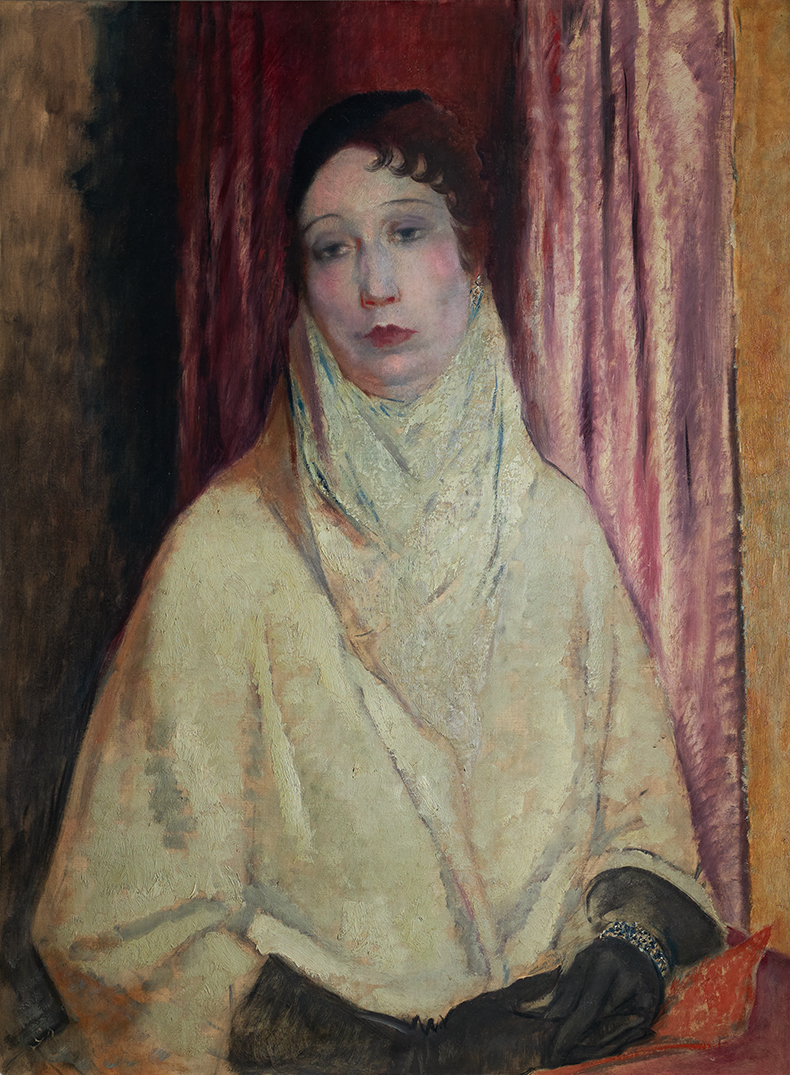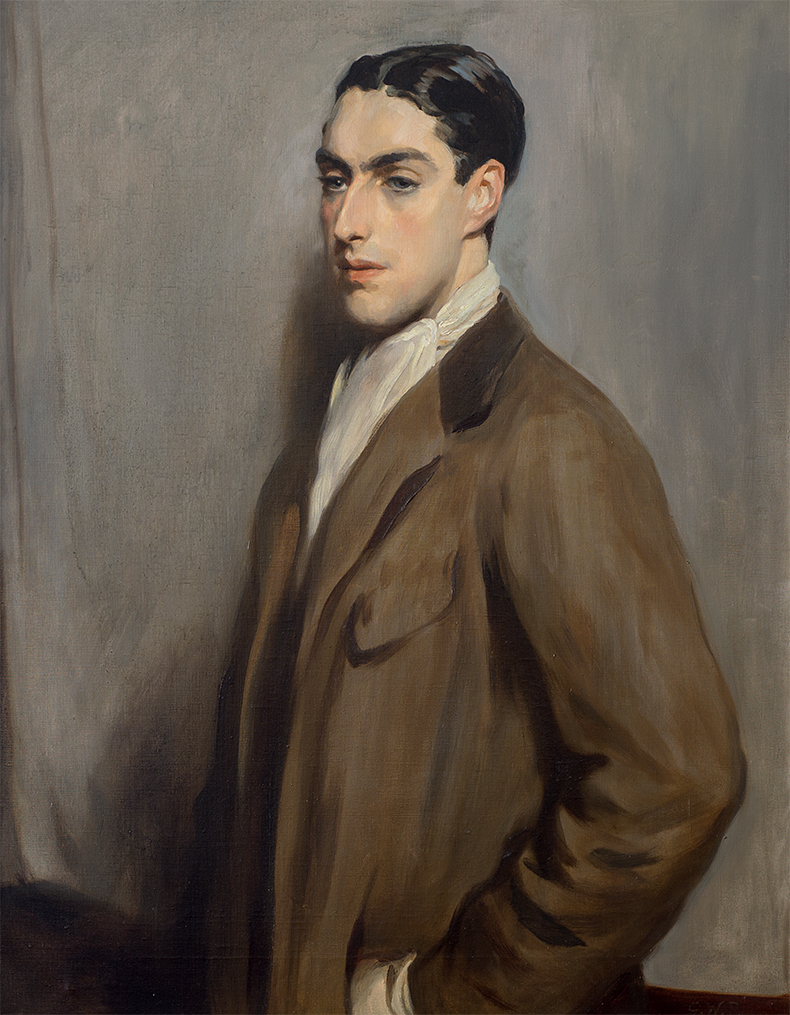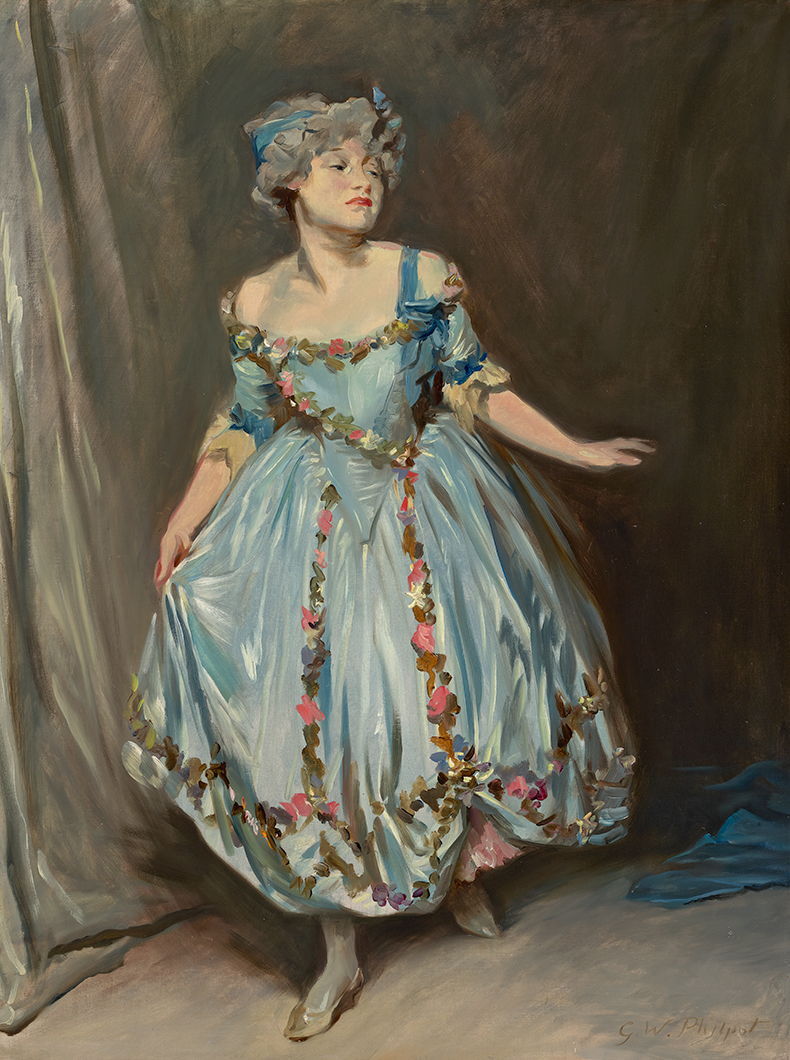One of Glyn Philpot’s haunting portraits currently on show at Pallant House Gallery, Chichester, is a work titled Madame C d’A (1932). Also known as The Opera Box, the painting shows a spectator swathed in a white cape and silk neck scarf, with a diamond and sapphire bracelet over her left wrist, her black gloved hands resting on a programme propped open against the ledge, eyes focused on the stage. Painted by Philpot in Paris, this striking woman with hennaed kiss curls, framed by red velvet curtains, was done from memory.

Madame C d’A (1932), Glyn Philpot. Private collection
I would like to suggest here that Madame C d’A depicts a member of the Cahen d’Anvers family, Jewish bankers established in Paris from the 1840s. At the recent conference at the Sorbonne, ‘Jewish Collectors and Patterns of Taste (1850–1930)’, I conferred with Alice Legé who, in the bucolic setting of the Dairy, spoke about the family’s lifestyle at the Château de Champs-sur-Marne. Acquired in 1895 by Louis Cahen d’Anvers, this château, associated with Madame de Pompadour, was given by Louis’s son Charles to the French nation in 1935.
Philpot’s subject is possibly Charles’s wife, Paris-born Suzanne Lévy, or his elder brother Robert’s wife, Sonia Warschawsky. Charles’s sister Irène, painted by Renoir as The Little Girl with the Blue Ribbon (1880), extended the family’s influence when she married Moïse de Camondo in 1891.
In Britain, Philpot’s career was furthered by a number of Jewish patrons – they included Cohens, Melchetts/Monds, Messels, Meyers, Rufus-Isaacs and Sassoons. Such families were well placed to commission the society portraits with which Philpot was associated from 1910, but, as the current exhibition demonstrates, Philip Sassoon and Henry Mond also instigated Philpot’s exciting interior schemes at Port Lympne near Dover and at Mulberry House in Westminster. As a Catholic convert and queer artist, Philpot welcomed Jewish cultural aspirations informed by international family networks.

Frank Meyer (1911), Glyn Philpot. Private collection. Photo: © Leo Bieber
Among Philpot’s earliest portraits of a Jewish sitter is that of my grandfather Frank Meyer. It was commissioned in 1910 by his father Hamburg-born Sir Carl, whose baronetcy was bestowed that year after contributing to the Memorial Fund to build a National Theatre for the tercentenary of Shakespeare’s death in 1916. A demure study, Frank’s portrait (not in the Pallant House exhibition) is enhanced by the greens and browns of his riding suit. It anticipates that of Philip Sassoon, painted four years later. In 1913 Sassoon acquired Philpot’s Head of an Ethiopian Man (Billy), an early example of Philpot’s focus on Black sitters, and Nijinsky before the Royal Opera House Curtain in L’Après-midi d’un faune (1913), which demonstrates the artist’s fascination with performance. Philpot also produced figurative sculpture in bronze and Sassoon’s portrait was praised by contemporary critics for its sculptural modelling.
Port Lympne was designed for Sassoon by the architects Herbert Baker and Philip Tilden. In 1923, Philpot painted a frieze for the dining room; a procession of Africans bearing offerings; a bare-chested woman reclines on a leopard and a naked man lounges on a white oxen, the figures inspired by Assyrian reliefs and Egyptian hieroglyphics and sculpture. In contrast Philpot’s portraits of children are more intimate and enquiring. At Nymans, the portrait of the young Oliver and Anne Messel from 1913 was sadly destroyed by fire, yet Oliver Messel remained a lifelong friend and, in 1929, introduced Philpot to the Jamaican model Henry Thomas.

Portrait Sketch of Mrs Emile Mond in her Costume for the Chelsea Arts Club Ball (1913), Glyn Philpot. Private collection
Philpot’s earliest commission from the Monds was from Emil Schweich, who joined his uncle’s Ludwig’s business, changed his name to Mond and married into the family; his wife Angela, neé Goetze, was the sister of Violet Mond. Philpot sketched her dressed as the 18th-century French dancer Marie Camargo – after Lancret’s painting in the Wallace Collection – for the Chelsea Arts Club Ball in 1912.
In 1927 Philpot painted Gwen, Mrs Henry Mond, the future 2nd Lady Melchett, seated on cushions on his studio floor in front of a Coromandel screen. Five years later, the Melchett’s Drawing Room in their Lutyens’ Westminster home was remodelled by Darcy Braddell, the architect of the large Mond family mausoleum in East Finchley, a Greek-styled Temple of Nemesis. Over the fireplace, Charles Sargeant Jagger’s bronze relief Scandal (1930) was punctuated below by a fire grate with hissing cats and parrot (both in the V&A); a satirical reference to the gossip surrounding the Monds’ ménage à trois with the writer Gilbert Cannan. Philpot was responsible for painting the silver foil-coloured walls, in grey, black, pale blue and pink, illustrating the Loves of Jupiter, Leda, Danaë and Echo. Narcissus, Oedipus and the Sphinx were set against a New York skyline inspired by Philpot’s recent visit to Manhattan. Hailed as ‘the most wonderful room in London’, subsequently destroyed, it is recorded in contemporary photographs and preparatory sketches. Philpot painted further portraits of Lord and Lady Melchett in the early 1930s to complement the Mulberry House scheme.
Philpot’s Jewish patrons encouraged the artist to engage with modernity yet also to evoke past civilisations. Yet the ownership of the mysterious painting of Madame C d’A indicates that it was not commissioned by the family but reflects her individuality; it was bought at the 1932 exhibition at London’s Leicester Galleries by St John Evers, a friend and former neighbour of the artist, who was a Wimbledon tennis player. Madame C d’A epitomises Philpot’s startling reinvention of the society portrait and his acute awareness of contemporary European artistic trends.
‘Glyn Philpot, Flesh and Spirit’ is at Pallant House Gallery, Chichester, until 23 October.

Putting a name to one of Glyn Philpot’s most mysterious faces
Madame C d’A (detail; 1932), Glyn Philpot.
Share
One of Glyn Philpot’s haunting portraits currently on show at Pallant House Gallery, Chichester, is a work titled Madame C d’A (1932). Also known as The Opera Box, the painting shows a spectator swathed in a white cape and silk neck scarf, with a diamond and sapphire bracelet over her left wrist, her black gloved hands resting on a programme propped open against the ledge, eyes focused on the stage. Painted by Philpot in Paris, this striking woman with hennaed kiss curls, framed by red velvet curtains, was done from memory.
Madame C d’A (1932), Glyn Philpot. Private collection
I would like to suggest here that Madame C d’A depicts a member of the Cahen d’Anvers family, Jewish bankers established in Paris from the 1840s. At the recent conference at the Sorbonne, ‘Jewish Collectors and Patterns of Taste (1850–1930)’, I conferred with Alice Legé who, in the bucolic setting of the Dairy, spoke about the family’s lifestyle at the Château de Champs-sur-Marne. Acquired in 1895 by Louis Cahen d’Anvers, this château, associated with Madame de Pompadour, was given by Louis’s son Charles to the French nation in 1935.
Philpot’s subject is possibly Charles’s wife, Paris-born Suzanne Lévy, or his elder brother Robert’s wife, Sonia Warschawsky. Charles’s sister Irène, painted by Renoir as The Little Girl with the Blue Ribbon (1880), extended the family’s influence when she married Moïse de Camondo in 1891.
In Britain, Philpot’s career was furthered by a number of Jewish patrons – they included Cohens, Melchetts/Monds, Messels, Meyers, Rufus-Isaacs and Sassoons. Such families were well placed to commission the society portraits with which Philpot was associated from 1910, but, as the current exhibition demonstrates, Philip Sassoon and Henry Mond also instigated Philpot’s exciting interior schemes at Port Lympne near Dover and at Mulberry House in Westminster. As a Catholic convert and queer artist, Philpot welcomed Jewish cultural aspirations informed by international family networks.
Frank Meyer (1911), Glyn Philpot. Private collection. Photo: © Leo Bieber
Among Philpot’s earliest portraits of a Jewish sitter is that of my grandfather Frank Meyer. It was commissioned in 1910 by his father Hamburg-born Sir Carl, whose baronetcy was bestowed that year after contributing to the Memorial Fund to build a National Theatre for the tercentenary of Shakespeare’s death in 1916. A demure study, Frank’s portrait (not in the Pallant House exhibition) is enhanced by the greens and browns of his riding suit. It anticipates that of Philip Sassoon, painted four years later. In 1913 Sassoon acquired Philpot’s Head of an Ethiopian Man (Billy), an early example of Philpot’s focus on Black sitters, and Nijinsky before the Royal Opera House Curtain in L’Après-midi d’un faune (1913), which demonstrates the artist’s fascination with performance. Philpot also produced figurative sculpture in bronze and Sassoon’s portrait was praised by contemporary critics for its sculptural modelling.
Port Lympne was designed for Sassoon by the architects Herbert Baker and Philip Tilden. In 1923, Philpot painted a frieze for the dining room; a procession of Africans bearing offerings; a bare-chested woman reclines on a leopard and a naked man lounges on a white oxen, the figures inspired by Assyrian reliefs and Egyptian hieroglyphics and sculpture. In contrast Philpot’s portraits of children are more intimate and enquiring. At Nymans, the portrait of the young Oliver and Anne Messel from 1913 was sadly destroyed by fire, yet Oliver Messel remained a lifelong friend and, in 1929, introduced Philpot to the Jamaican model Henry Thomas.
Portrait Sketch of Mrs Emile Mond in her Costume for the Chelsea Arts Club Ball (1913), Glyn Philpot. Private collection
Philpot’s earliest commission from the Monds was from Emil Schweich, who joined his uncle’s Ludwig’s business, changed his name to Mond and married into the family; his wife Angela, neé Goetze, was the sister of Violet Mond. Philpot sketched her dressed as the 18th-century French dancer Marie Camargo – after Lancret’s painting in the Wallace Collection – for the Chelsea Arts Club Ball in 1912.
In 1927 Philpot painted Gwen, Mrs Henry Mond, the future 2nd Lady Melchett, seated on cushions on his studio floor in front of a Coromandel screen. Five years later, the Melchett’s Drawing Room in their Lutyens’ Westminster home was remodelled by Darcy Braddell, the architect of the large Mond family mausoleum in East Finchley, a Greek-styled Temple of Nemesis. Over the fireplace, Charles Sargeant Jagger’s bronze relief Scandal (1930) was punctuated below by a fire grate with hissing cats and parrot (both in the V&A); a satirical reference to the gossip surrounding the Monds’ ménage à trois with the writer Gilbert Cannan. Philpot was responsible for painting the silver foil-coloured walls, in grey, black, pale blue and pink, illustrating the Loves of Jupiter, Leda, Danaë and Echo. Narcissus, Oedipus and the Sphinx were set against a New York skyline inspired by Philpot’s recent visit to Manhattan. Hailed as ‘the most wonderful room in London’, subsequently destroyed, it is recorded in contemporary photographs and preparatory sketches. Philpot painted further portraits of Lord and Lady Melchett in the early 1930s to complement the Mulberry House scheme.
Philpot’s Jewish patrons encouraged the artist to engage with modernity yet also to evoke past civilisations. Yet the ownership of the mysterious painting of Madame C d’A indicates that it was not commissioned by the family but reflects her individuality; it was bought at the 1932 exhibition at London’s Leicester Galleries by St John Evers, a friend and former neighbour of the artist, who was a Wimbledon tennis player. Madame C d’A epitomises Philpot’s startling reinvention of the society portrait and his acute awareness of contemporary European artistic trends.
‘Glyn Philpot, Flesh and Spirit’ is at Pallant House Gallery, Chichester, until 23 October.
Share
Recommended for you
Cult status – the idiosyncratic portraits of Glyn Philpot
The painter’s contemporaries saw him as a successor to Sargent, but his depictions of Black and queer subjects may stand out more today
Oswald Birley’s society portraits should have a wider public
The portraitist was highly sought after in his heyday, but his reputation has languished in recent years
‘Thomas McKeller was singular among Sargent’s pantheon of models’
What did it mean for a wildly successful artist to paint a black elevator operator in stuffy Boston society?